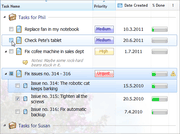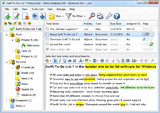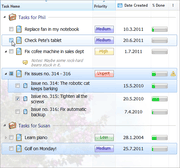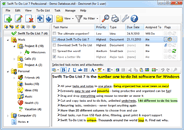Software uninstall surveys are an invaluable marketing, sales and feedback tool. If you are currently not collecting uninstall surveys, this post might make you reconsider.
What is an uninstall survey? It is a form that users who uninstall your software are asked to fill and submit, and the results are sent to you. The survey should be always optional and non-obtrusive.
Why should you do uninstall surveys
As with almost everything in business, the main reason for doing uninstall surveys is to increase your profit, and spot any issues that prevent your users from being happy with your products.
Uninstall surveys help you boost profit in multiple ways:
- You will get useful, actionable feedback. (More on this later)
- You can make a sale by offering a discount or another special deal.
- You can offer the user an alternative product.
- You can collect email addresses, to get back to your users.
Uninstall surveys allow you to take advantage of many monetization, business development and customer relationship building opportunities.
How to do uninstall surveys
The best way is to probably create a hidden “Why have you uninstalled My Awesome App?” page on your website. Do not link to it from anywhere on your website, open it only directly from the uninstaller of your software.
When someone uninstalls your software, simply launch the URL from the uninstaller. ShellExecute will do.
If you use Inno Setup, you can use the following code:
procedure CurUninstallStepChanged(CurUninstallStep: TUninstallStep);
var ErrorCode:integer;
begin
if IsUninstaller and not UninstallSilent then begin
if CurUninstallStep = usDone then begin
ShellExec('open', 'http://www.mywebsite.com/why-uninstall-my-awesome-app', '', '', SW_SHOW, ewWaitUntilTerminated, ErrorCode);
end;
end;
end;
There is also an Inno setup .dll plugin which allows you to do the uninstall survey directly from the uninstaller, but I do not recommend it for two reasons – first, it is prone to firewall issues. Second, it doesn’t give you the same flexibility as a page on your website, which you can change at any time to introduce new promotions, tweaks, etc.
You probably shouldn’t launch the URL for users that have already purchased your application. Check for the presence of a valid registration in the uninstaller, and when detected, don’t launch the URL with the uninstall survey. (You do not need to validate the registration, just quickly check if the reg. info is stored.)
If you want to get fancy, you can also submit the Windows version to the uninstall survey page via HTTP GET method from the uninstaller.
Designing your “Why Uninstall?” Page
If you are selling multiple products, you should have a separate why uninstall page for every of your products.
The design of the why uninstall page depends entirely on your goals. Our uninstall form looks basically like this:
Reason: [Dropdown list of possible reasons]
Comments: [Multi-line text area]
Email address (Optional):
But, for example, if we were offering a mature enterprise product, I would probably remove the Reason dropdown, and make email address non-optional.
The “Reason” dropdown can include these reasons:
- Can’t start the program (What happens?)
- Expensive
- Complex
- Hard to use
- Missing features (Which?)
- Too short trial
- Crashes, errors
- Found another program (Which?)
Customize this list. E.g. if you are aware of some very important feature that is missing in your product, add it to the list of reasons.
It doesn’t hurt to include some graphics or stock photo to capture attention. It can be a sundown, a sad puppy, sailboat disappearing in a distance – just about anything that represents “leaving”. Making it emotional will probably slightly increase the number of answers you will receive, but do not try to induce guilt in the user. It is okay to say “We are sorry to see you go”, but don’t communicate exaggerated despair or be manipulative.
Furthermore, your uninstall survey should communicate trust, just like your buy page. You can include your mailing address, assure the user that you won’t share or spam his email address, include any “trusted” badges/logos that your site has, etc. You can also place a little “shield” icon into the “Submit” button of the uninstall survey, which conveys trust and confidentiality.
You can also make it personal – include your photo and signature, and communicate that you really care about offering the best possible product, and give the user the opportunity to help you out.
Getting the most out of the uninstall surveys
The cool thing is that you can take an action based on the uninstallation reason the user has reported.
Some of these actions can be even automated.
- Trial is too short? Extend the trial for that user.
- The program is too expensive? Offer a discount.
- Errors are present? Make a fix and send it to the user.
- The program is hard to use? Educate the user, and update your help files and guides.
- The program is too complex? Offer your simpler product.
- The program is too simple? Offer your more advanced product.
You get the idea.
If your application is priced low (below $50), consider utilizing TrialPay.
TrialPay allows your users to get your app for free, in exchange for signing-up for a trial of a 3rd-party product, or completing some offer from one of the TrialPay partners. You will then be paid by TrialPay. You will most likely get higher conversion rates with TrialPay than by offering a discount yourself, but the average payout will be probably lower. You need to test this yourself – it depends on your product. I would say that popular, broad consumer-oriented products would work best with TrialPay.
The most important thing is to reply to everyone who left their email address, either automatically, or personally, and try to “save” the sale. It might seem like it’s not worth it, but you can achieve pretty amazing conversion rates.
Think about the survey participants as folks who are sitting on the fence. Reaching to them and showing that you care is sometimes all you need to do in order to win them over, especially if you also offer them a discount.
Feedback full of golden nuggets
The feedback you will get from the uninstall surveys can be extremely valuable.
Just think about it – when multiple users say “I would purchase your product if it had a feature X”, then it is almost guaranteed that if you include the feature X, your sales will increase.
Or, if only a small fraction of the survey participants state that the product is too expensive, your pricing is probably too low.
A typical participant of the uninstall survey will probably be different from a typical user that emails you directly. There is some overlap, but getting the feedback from the former group can be very, very valuable.
I’m always happy to help. If you have any questions or comments, reach me at novotny@dextronet.com








